North American Winter Dipole: Observed and Simulated Changes in Circulations
Abstract
1. Introduction
2. Data Sources
2.1. Observations
2.2. Simulations
2.3. NAWD-Related Climate Indices
3. Long-Term Change in Leading Circulation Pattern across North America
3.1. Evolution of Pattern Change
3.2. Past NAWD
3.3. Possible Forcing Change
4. Conclusions
Author Contributions
Funding
Acknowledgments
Conflicts of Interest
Abbreviations
| 20CR | NOAA Twentieth Century Reanalysis version 2c |
| AO | Arctic Oscillation |
| AGCM | Atmospheric General circulation model |
| B.P. | Before Present; 1950A.D. |
| CESM | Community Earth System Model |
| ECMWF | European Centre for Medium-Range Weather Forecasts |
| ERA-20C | ECMWF global reanalysis products for the twentieth century |
| EOF | Empirical Orthogonal Function |
| ENSO | El Nino/Southern Oscillation |
| LGM | Last Glacial Maximum |
| NH | North Hemisphere |
| NOI | Northern Oscillation index |
| PC | Principle Component |
| PDO | Pacific Decadal Oscillation |
| PNA | Pacific–North America |
| SST | Sea surface temperature |
| SSTA | Sea surface temperature anomaly |
| TNH | Tropical Northern Hemisphere pattern |
| WAF | Wave activity flux |
| WNP | Western North Pacific pattern |
| WP | Western Pacific pattern |
References
- NOAA National Centers for Environmental Information (NCEI). U.S. Billion-Dollar Weather and Climate Disasters. 2019. Available online: https://www.ncdc.noaa.gov/billions/ (accessed on 3 December 2019).
- Singh, D.; Swain, D.L.; Mankin, J.S.; Horton, D.E.; Thomas, L.N.; Rajaratnam, B.; Diffenbaugh, N.S. Recent amplification of the North American winter temperature dipole. J. Geophys. Res. Atmos. 2016, 121, 9911–9928. [Google Scholar] [CrossRef] [PubMed]
- Wang, S.-Y.S.; Huang, W.-R.; Yoon, J.-H. The North American winter ‘dipole’ and extremes activity: A CMIP5 assessment. Atmos. Sci. Lett. 2015, 16, 338–345. [Google Scholar] [CrossRef]
- Wang, S.-Y.S.; Yoon, J.-H.; Becker, E.; Gillies, R. California from drought to deluge. Nat. Clim. Chang. 2017, 7, 465–468. [Google Scholar] [CrossRef]
- Stuivenvolt-Allen, J.; Wang, S.-Y.S. Data Mining Climate Variability as an Indicator of U.S. Natural Gas. Front. Big Data 2019, 2, 20. [Google Scholar] [CrossRef]
- Voelker, S.L.; Wang, S.-Y.; Dawson, T.E.; Roden, J.S.; Still, C.J.; Longstaffe, F.J.; Ayalon, A. Tree-ring isotopes adjacent to Lake Superior reveal cold winter anomalies for the Great Lakes region of North America. Sci. Rep. 2019, 9, 4412. [Google Scholar] [CrossRef] [PubMed]
- Swain, D.L.; Tsiang, M.; Haugen, M.; Singh, D.; Charland, A.; Rajaratnam, B.; Diffenbaugh, N.S. The extraordinary California drought of 2013/2014: Character, context, and the role of climate change [in “Explaining Extremes of 2013 from a Climate Perspective”]. Bull. Am. Meteorol. Soc. 2014, 95, S3–S7. [Google Scholar]
- Hartmann, D.L. Pacific sea surface temperature and the winter of 2014. Geophys. Res. Lett. 2015, 42, 1894–1902. [Google Scholar] [CrossRef]
- Schulte, J.A.; Lee, S. Strengthening North Pacific influences on United States temperature variability. Sci. Rep. 2017, 7, 124. [Google Scholar] [CrossRef]
- Francis, J.A.; Vavrus, S.J. Evidence linking Arctic amplification to extreme weather in mid-latitudes. Geophys. Res Lett. 2012, 22, L068601. [Google Scholar] [CrossRef]
- Overland, J.E.; Dethloff, K.; Francis, J.A.; Hall, R.J.; Hanna, E.; Kim, S.; Screen, J.A.; Shepherd, T.G.; Vihma, T. Nonlinear response of mid-latitude weather to the changing Arctic. Nat. Clim. Chang. 2016, 6, 992–999. [Google Scholar] [CrossRef]
- Swain, D.L.; Langenbrunner, B.; Neelin, J.D.; Hall, A. Increasing precipitation volatility in twenty-first-century California. Nat. Clim. Chang. 2018, 8, 427. [Google Scholar] [CrossRef]
- Yoon, J.H.; Wang, S.S.; Gillies, R.R.; Kravitz, B.; Hipps, L.; Rasch, P.J. Increasing water cycle extremes in California and in relation to ENSO cycle under global warming. Nat. Commun. 2015, 6, 8657. [Google Scholar] [CrossRef] [PubMed]
- Wang, S.-Y.; Hipps, L.; Gillies, R.R.; Yoon, J.-H. Probable causes of the abnormal ridge accompanying the 2013–2014 California drought: ENSO precursor and anthropogenic warming footprint. Geophys. Res. Lett. 2014, 41, 3220–3226. [Google Scholar] [CrossRef]
- Kalnay, E.; Kanamitsu, M.; Kistler, R.; Collins, W.; Deaven, D.; Gandin, L.; Iredell, M.; Saha, S.; White, G.; Woollen, J. The NCEP/NCAR 40-year reanalysis project. Bull. Am. Meteorol. Soc. 1996, 77, 437–472. [Google Scholar] [CrossRef]
- Dee, D.P.; Uppala, S.M.; Simmons, A.J.; Berrisford, P.; Poli, P.; Kobayashi, S.; Andrae, U.; Balmaseda, M.A.; Balsamo, G.; Bauer, P.; et al. The ERA-Interim reanalysis: Configuration and performance of the data assimilation system. Q. J. R. Meteorol. Soc. 2011, 137, 553–597. [Google Scholar] [CrossRef]
- Uppala, S.M.; KÅllberg, P.W.; Simmons, A.J.; Andrae, U.; Da Costa Bechtold, V.; Fiorino, M.; Gibson, J.K.; Haseler, J.; Hernandez, A.; Kelly, G.A.; et al. The ERA-40 re-analysis. Q. J. R. Meteorol. Soc. 2005, 131, 2961–3012. [Google Scholar] [CrossRef]
- Poli, P.; Hersbach, H.; Dee, D.P. ERA-20C: An atmospheric reanalysis of the twentieth century. J. Clim. 2016, 29, 4083–4097. [Google Scholar] [CrossRef]
- Huang, B.; Banzon, V.F.; Freeman, E.; Lawrimore, J.; Liu, W.; Peterson, T.C.; Smith, T.M.; Thorne, P.W.; Woodruff, S.D.; Zhang, H.-M. Extended Reconstructed Sea Surface Temperature version 4 (ERSST.v4): Part I. Upgrades and intercomparisons. J. Clim. 2014, 28, 911–930. [Google Scholar] [CrossRef]
- Kay, J.E.; Deser, C.; Phillips, A.; Mai, A.; Hannay, C.; Strand, G.; Arblaster, J.M.; Bates, S.C.; Danabasoglu, G.; Edwards, J.; et al. The Community Earth System Model (CESM) large ensemble project. Bull. Am. Meteorol. Soc. 2015, 96, 1333–1349. [Google Scholar] [CrossRef]
- Pegion, K.V.; Selman, C. Extratropical Precursors of the El Niño–Southern Oscillation. In Climate Extremes: Patterns and Mechanisms; Wiley: Hoboken, NJ, USA, 2017; pp. 299–314. [Google Scholar]
- Bond, N.A.; Cronin, M.F.; Freeland, H.; Mantua, N. Causes and impacts of the 2014 warm anomaly in the NE Pacific. Geophys. Res. Lett. 2015, 42, 3414–3420. [Google Scholar] [CrossRef]
- Lorenzo, E.; Mantua, N. Multi-year persistence of the 2014/2015 North Pacific marine heatwave. Nat. Clim. Chang. 2016, 6, 1042–1047. [Google Scholar] [CrossRef]
- Higgins, R.W.; Schemm, J.-K.E.; Shi, W.; Leetmaa, A. Extreme precipitation events in the western United States related to tropical forcing. J. Clim. 2000, 13, 793–820. [Google Scholar] [CrossRef]
- Horel, J.D.; Wallace, J.M. Planetary-scale atmospheric phenomena associated with the Southern Oscillation. Mon. Weather Rev. 1981, 109, 813–829. [Google Scholar] [CrossRef]
- North, G.R.; Bell, T.L.; Cahalan, R.F. Sampling errors in the estimation of empirical orthogonal functions. Mon. Weather Rev. 1982, 110, 699–706. [Google Scholar] [CrossRef]
- Kintisch, E. ‘The Blob’ invades Pacific, flummoxing climate experts. Science 2015, 348, 17–18. [Google Scholar] [CrossRef]
- Wang, S.-Y.; L’Heureux, M.; Chia, H.-H. ENSO prediction one year in advance using Western North Pacific sea surface temperatures. Geophys. Res. Lett. 2012, 39. [Google Scholar] [CrossRef]
- Wang, S.-Y.; L’Heureux, M.; Yoon, J.-H. Are greenhouse gases changing ENSO precursors in the Western North Pacific? J. Clim. 2013, 26, 6309–6322. [Google Scholar] [CrossRef]
- Capotondi, A.; Sardeshmukh, P.D. Optimal precursors of different types of ENSO events. Geophys. Res. Lett. 2015, 42, 9952–9960. [Google Scholar] [CrossRef]
- Zhang, X.; Sorteberg, A.; Zhang, J.; Gerdes, R.; Comiso, J.C. Recent radical shifts of the atmospheric circulations and rapid changes in the Arctic climate system. Geophys. Res. Lett. 2008, 35, L22701. [Google Scholar] [CrossRef]
- Zhou, Z.-Q.; Xie, S.-P.; Zheng, X.-T.; Liu, Q.; Wang, H. Global warming-induced changes in El Niño teleconnections over the North Pacific and North America. J. Clim. 2014, 27, 9050–9064. [Google Scholar] [CrossRef]
- Johnson, N.C.; Feldstein, S.B. The continuum of North Pacific sea level pressure patterns: Intraseasonal, interannual, and interdecadal variability. J. Clim. 2010, 23, 851–867. [Google Scholar] [CrossRef]
- Chang, E.K.M. Diabatic and orographic forcing of northern winter stationary waves and storm tracks. J Clim. 2009, 22, 670–688. [Google Scholar] [CrossRef]
- Takaya, K.; Nakamura, H. A formulation of a phase-independent wave-activity flux for stationary and migratory quasi-geostrophic eddies on a zonally varying basic flow. J. Atmos. Sci. 2001, 58, 608–627. [Google Scholar] [CrossRef]
- Williams, J.W.; Shuman, B.N.; Webb, T.; Bartlein, P.J.; Leduc, P.L. Late-quaternary vegetation dynamics in north america: Scaling from taxa to biomes. Ecol. Monogr. 2004, 74, 309–334. [Google Scholar] [CrossRef]
- Lee, M.-Y.; Hong, C.-C.; Hsu, H.-H. Compounding effects of warm sea surface temperature and reduced sea ice on the extreme circulation over the extratropical North Pacific and North America during the 2013–2014 boreal winter. Geophys. Res. Lett. 2015, 42, 1612–1618. [Google Scholar] [CrossRef]
- Zhang, R.; Delworth, T.L. Impact of the Atlantic multidecadal oscillation on North Pacific climate variability. Geophys. Res. Lett. 2007, 34, L23708. [Google Scholar] [CrossRef]

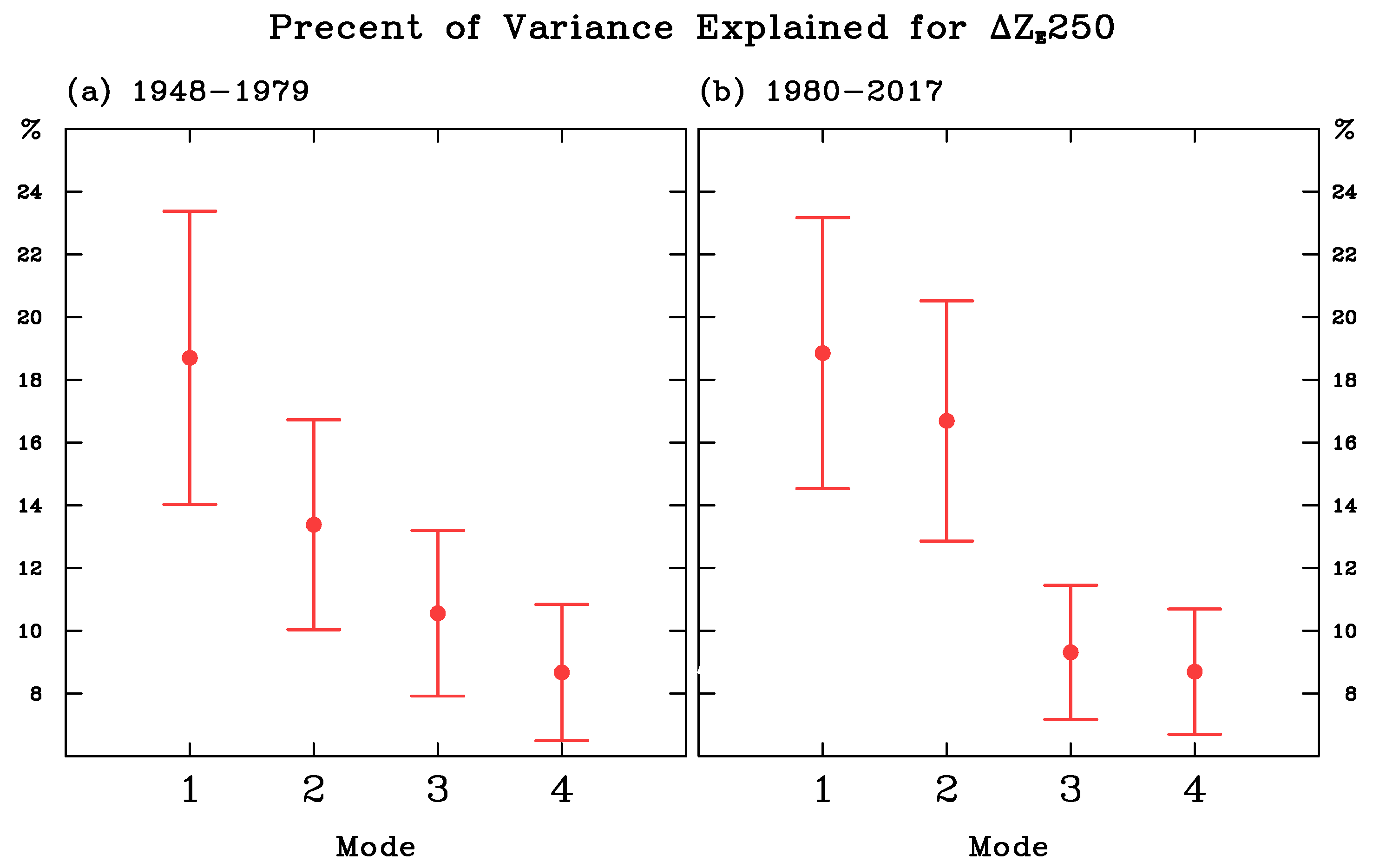
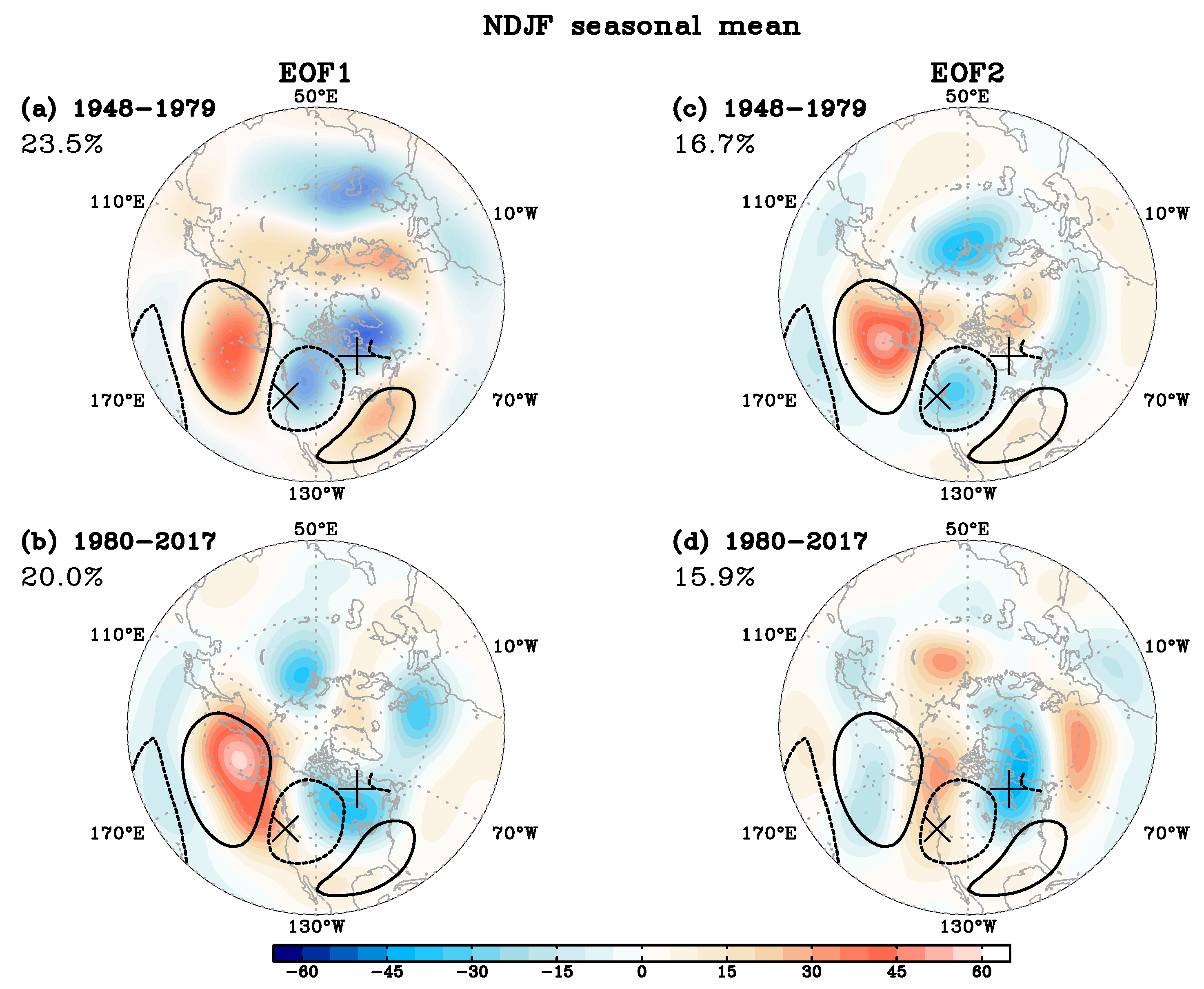
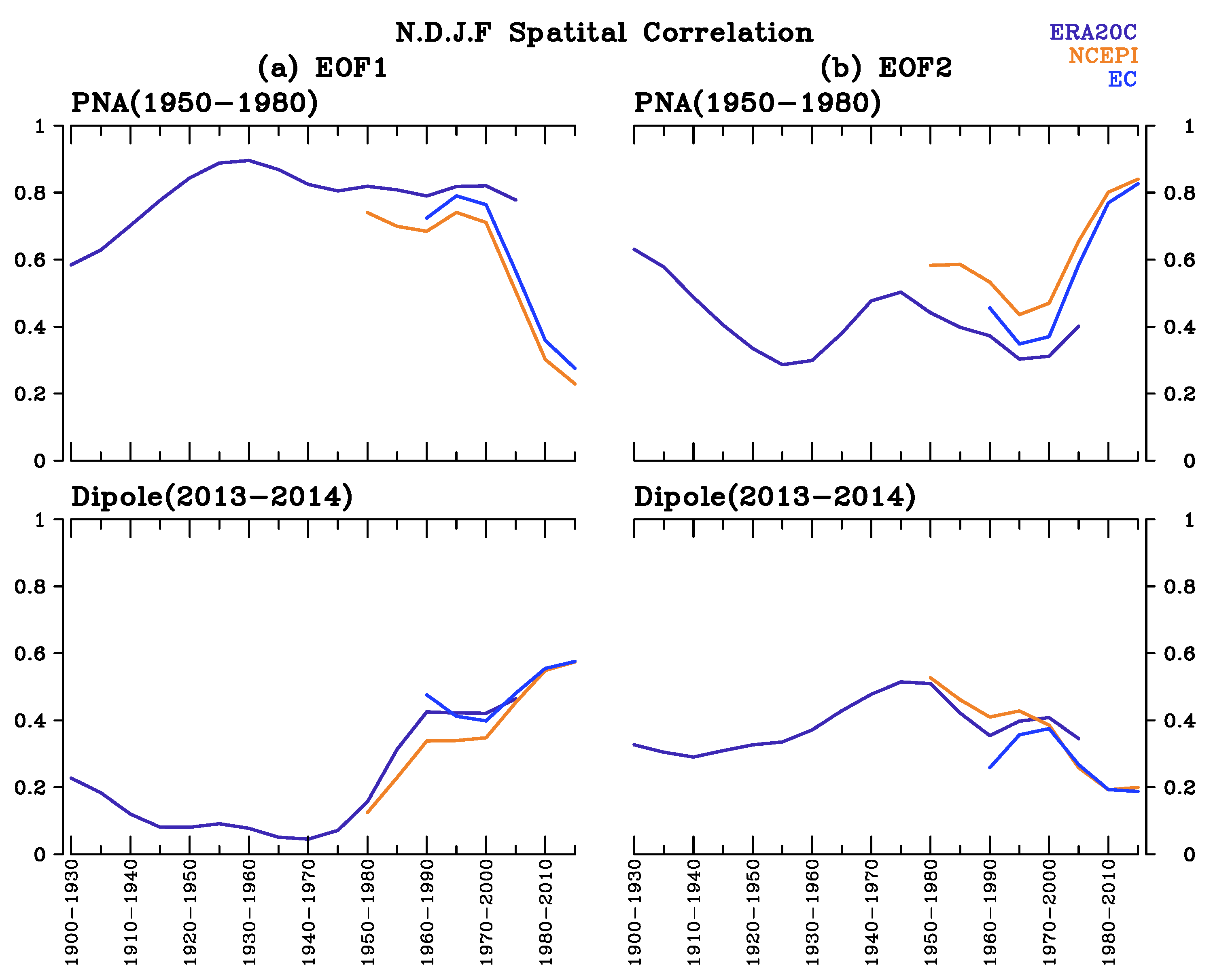
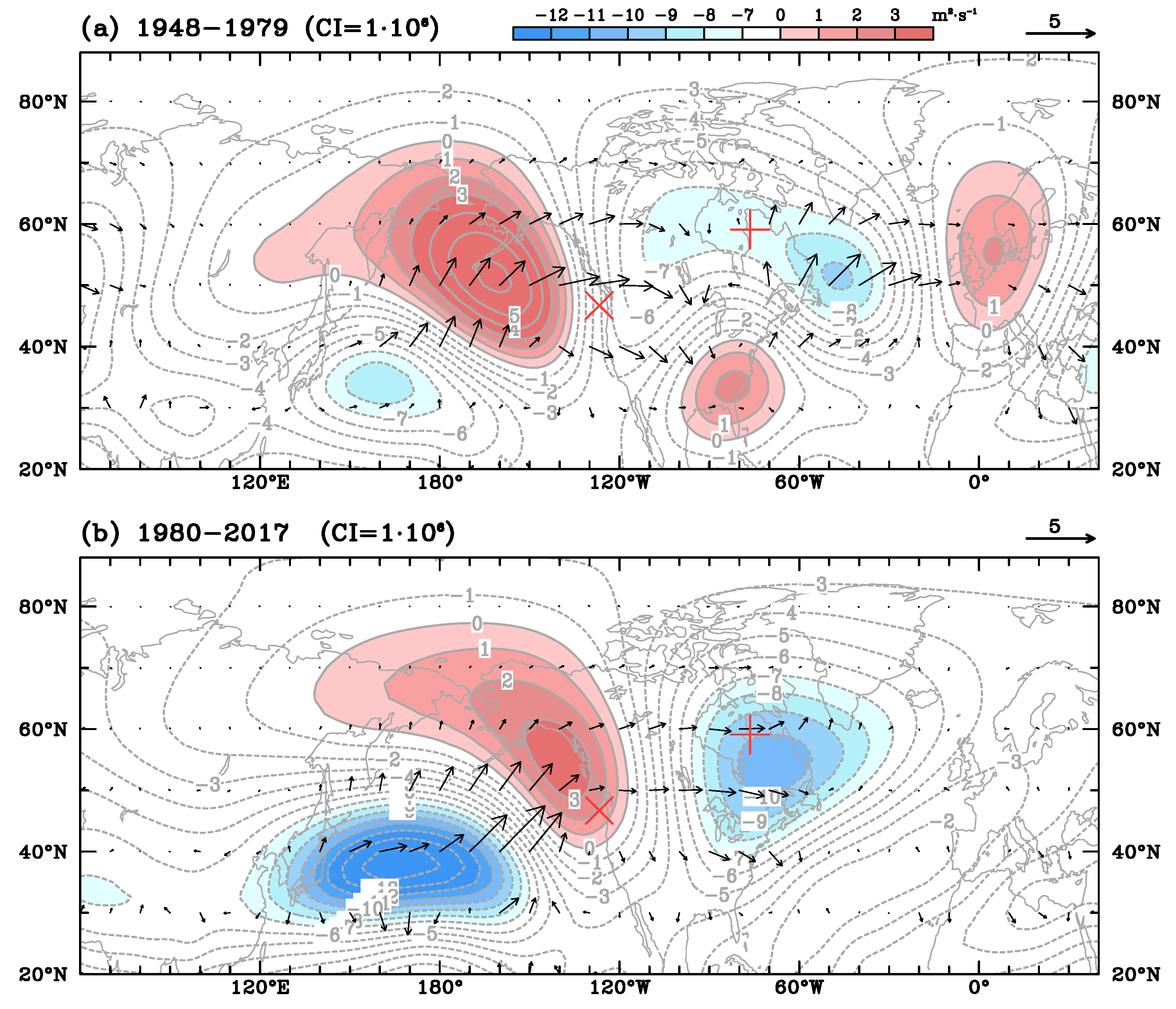
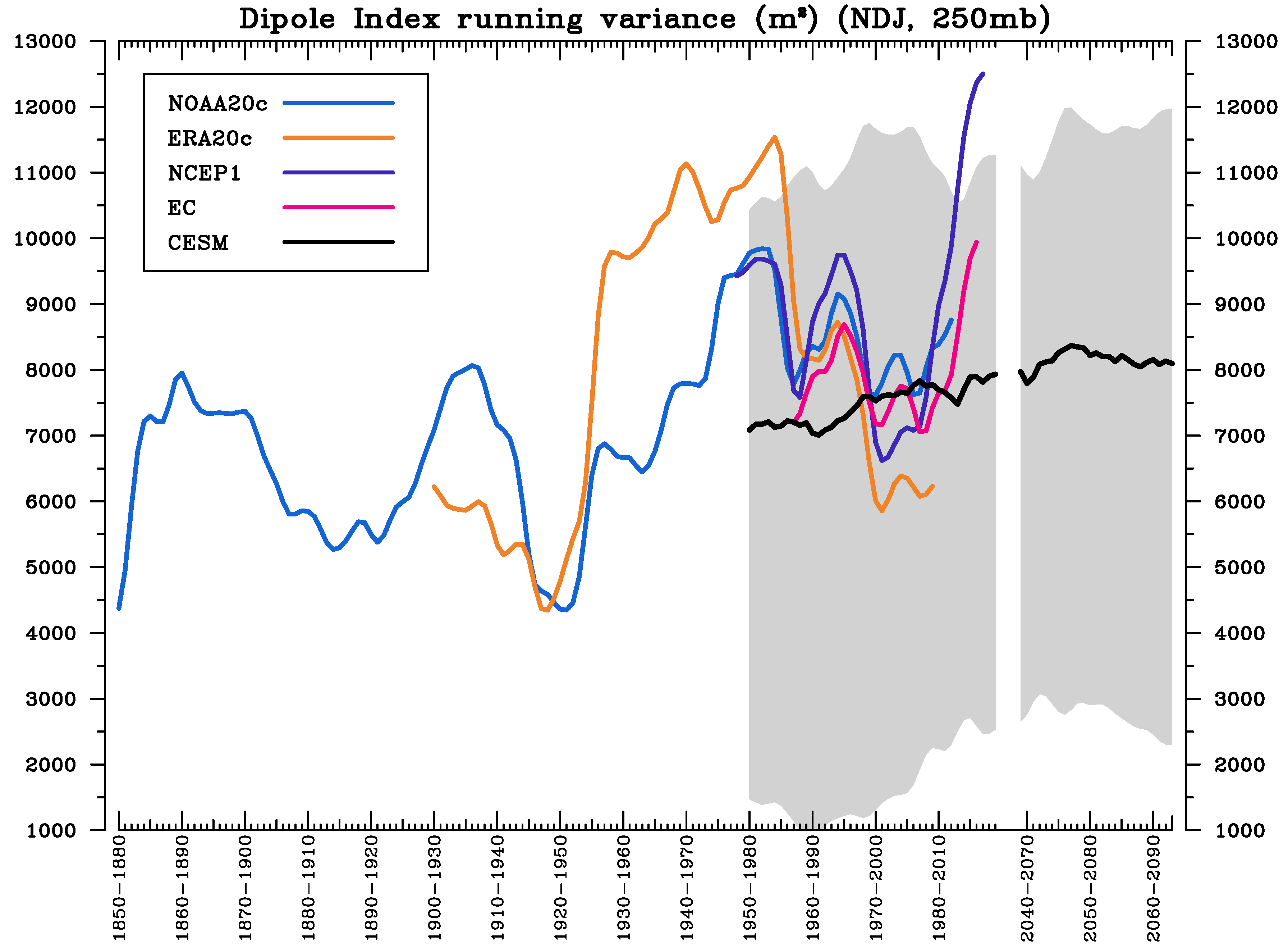
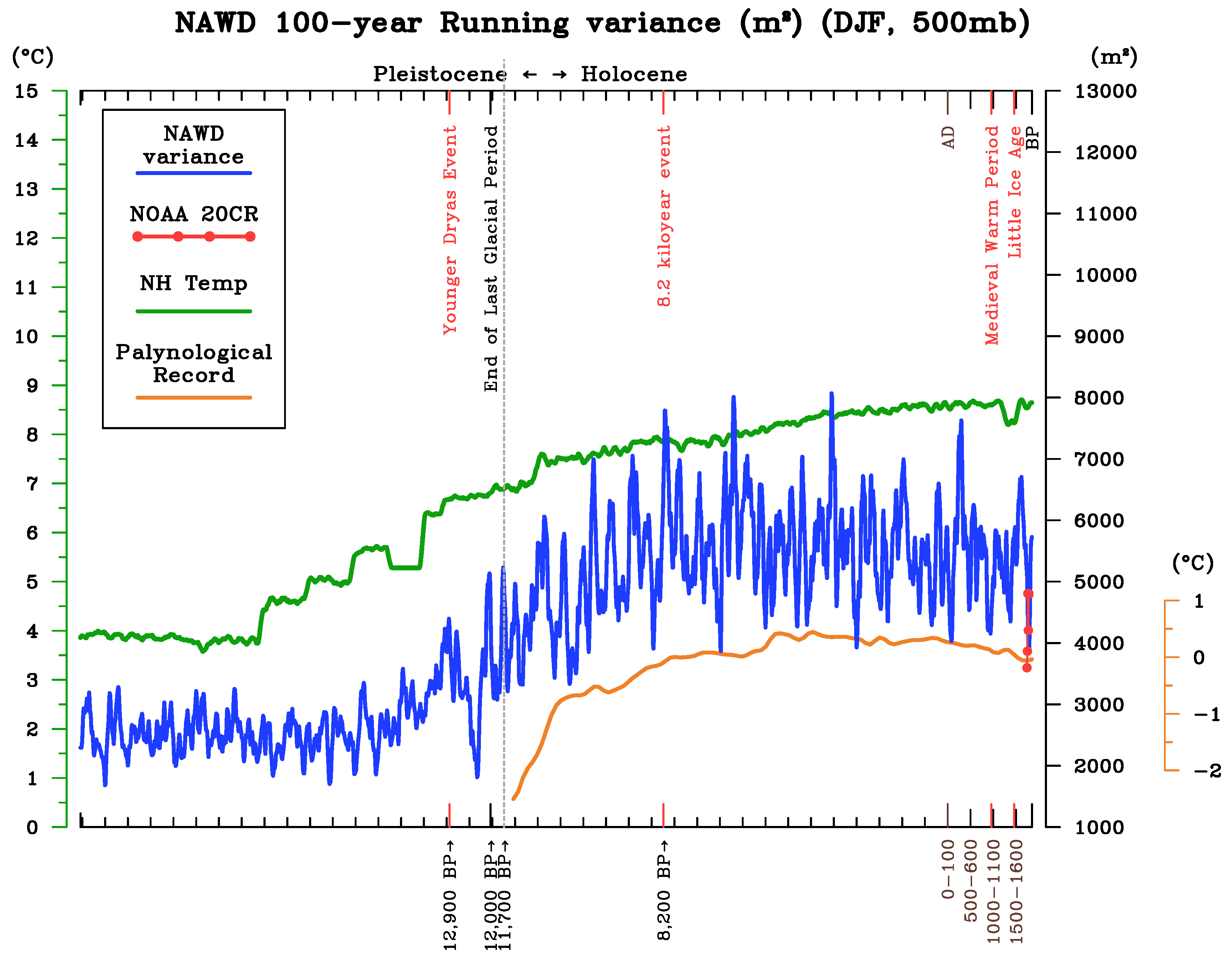
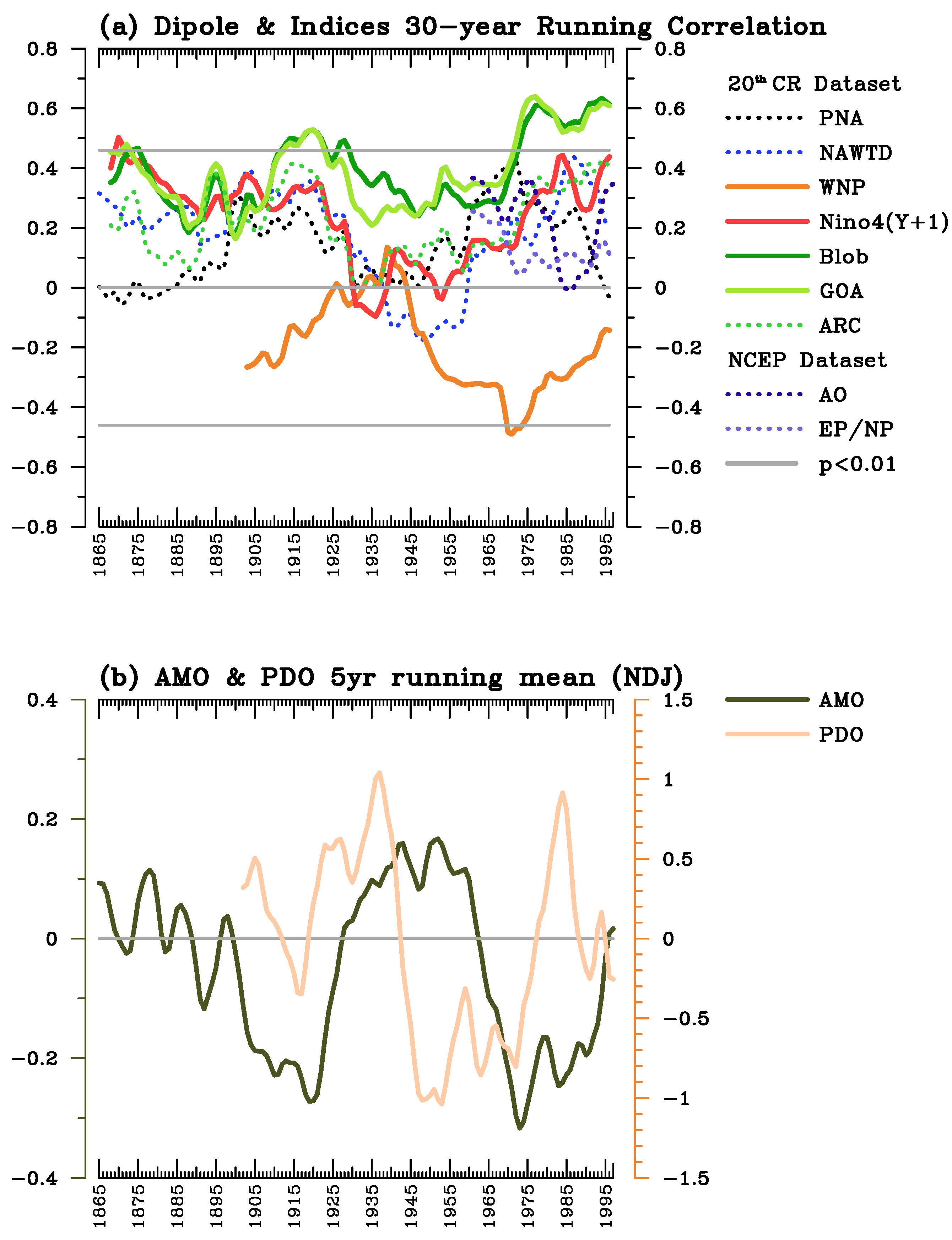
| Index | Brief Description | Reference |
|---|---|---|
| PNA | Pacific/North American Pattern: | Leathers, David. J. (1991) |
| The variation of atmospheric circulation patterns over the Pacific Ocean and North America. | ||
| NAWTD | North American Winter Temperature Dipole: | Singh et al. (2016) |
| A similar warm-west and cool-east surface temperature dipole pattern in North America | ||
| WNP | Western North Pacific: | Wang et al., 2013 |
| Connecting the major ENSO precursors | ||
| EP/NP | East Pacific/North Pacific: | Schulte and Lee (2017) |
| The positive phase is associated with an amplified jet stream configuration in which a ridge is situated over Alaska and a trough is situated over the eastern US. | Schulte and Georgas (2017) | |
| AO | Arctic Oscillation: | Schulte and Lee (2017) |
| When the AO is in its positive phase, a ring of strong winds circulating around the North Pole acts to confine colder air across polar regions. | ||
| AMO | Atlantic Multidecadal Oscillation: | Zhang and Delworth (2007) |
| A long-duration changes in the sea surface temperature of the North Atlantic Ocean, with cool and warm phases that may last for 20–40 years. | ||
| PDO | Pacific decadal Oscillation: | Mantua, Nathan. J. (1997) |
| Leading PC of monthly SST anomalies in the North Pacific Ocean | ||
| Nino 4 | East Central Tropical Pacific SST | CPC |
| (Y + 1) | (5 N–5 S; 170–120 W) | |
| Blob | Pacific blob region: (40–50 N, 150–135 W) | Kintisch (2015) |
| The remarkably warm water mass in the northeastern (NE) Pacific that persisted during 2013–2015 | ||
| GOA | Gulf of Alaska index: | Lorenzo and Mantua (2016) |
| This index directed from (1) SSTa and (2) SLPa. The region defined by the 2014/2015 SST peak anomalies near the Gulf of Alaska. | ||
| ARC | ARC pattern: | Lorenzo and Mantua (2016) |
| This index is directed from (1) SSTa and (2) SLPa. Identified by the largest warm anomalies along the entire Pacific North American coastal boundary. |
© 2019 by the authors. Licensee MDPI, Basel, Switzerland. This article is an open access article distributed under the terms and conditions of the Creative Commons Attribution (CC BY) license (http://creativecommons.org/licenses/by/4.0/).
Share and Cite
Chien, Y.-T.; Wang, S.-Y.S.; Chikamoto, Y.; Voelker, S.L.; Meyer, J.D.D.; Yoon, J.-H. North American Winter Dipole: Observed and Simulated Changes in Circulations. Atmosphere 2019, 10, 793. https://doi.org/10.3390/atmos10120793
Chien Y-T, Wang S-YS, Chikamoto Y, Voelker SL, Meyer JDD, Yoon J-H. North American Winter Dipole: Observed and Simulated Changes in Circulations. Atmosphere. 2019; 10(12):793. https://doi.org/10.3390/atmos10120793
Chicago/Turabian StyleChien, Yu-Tang, S.-Y. Simon Wang, Yoshimitsu Chikamoto, Steve L. Voelker, Jonathan D. D. Meyer, and Jin-Ho Yoon. 2019. "North American Winter Dipole: Observed and Simulated Changes in Circulations" Atmosphere 10, no. 12: 793. https://doi.org/10.3390/atmos10120793
APA StyleChien, Y.-T., Wang, S.-Y. S., Chikamoto, Y., Voelker, S. L., Meyer, J. D. D., & Yoon, J.-H. (2019). North American Winter Dipole: Observed and Simulated Changes in Circulations. Atmosphere, 10(12), 793. https://doi.org/10.3390/atmos10120793





